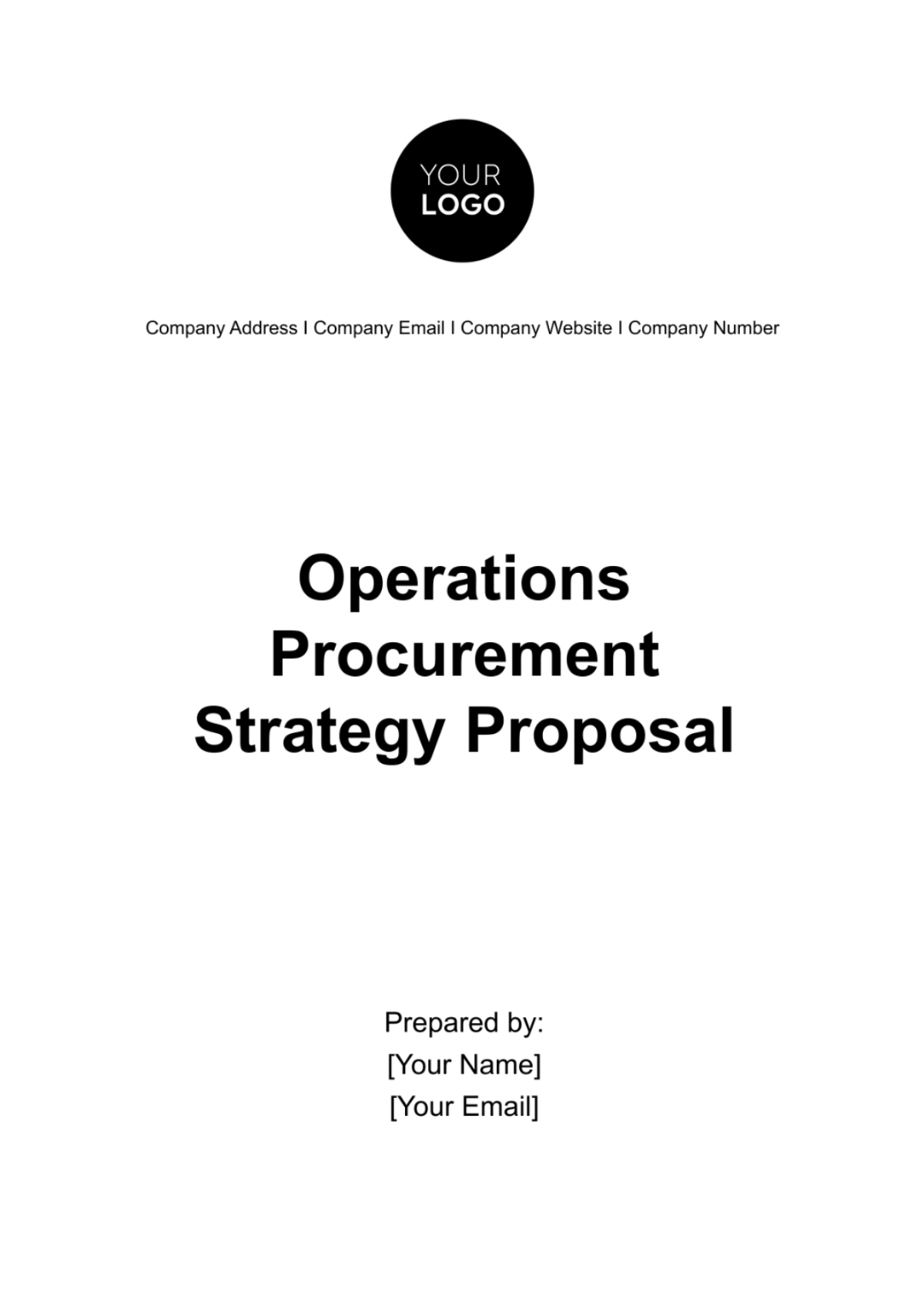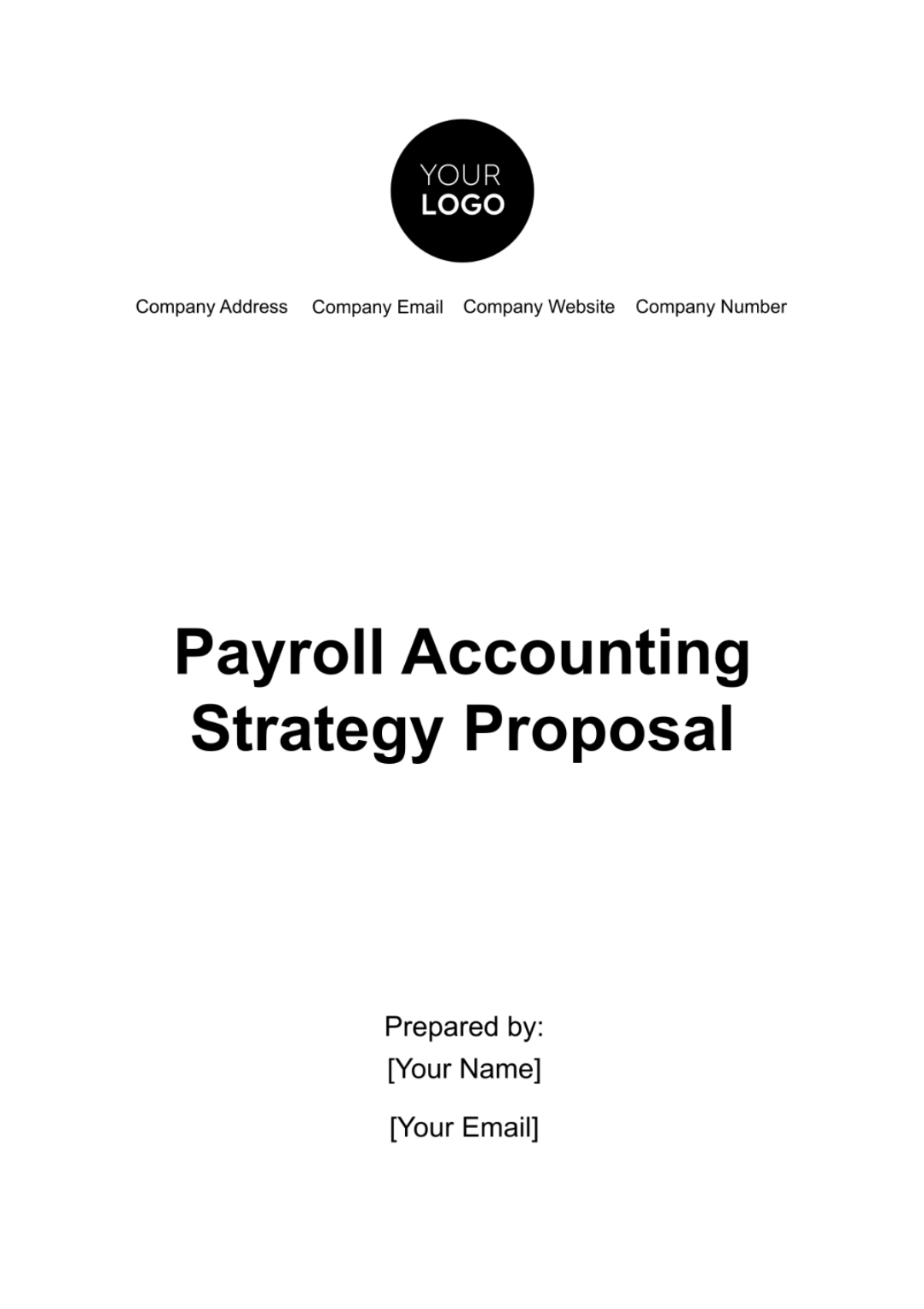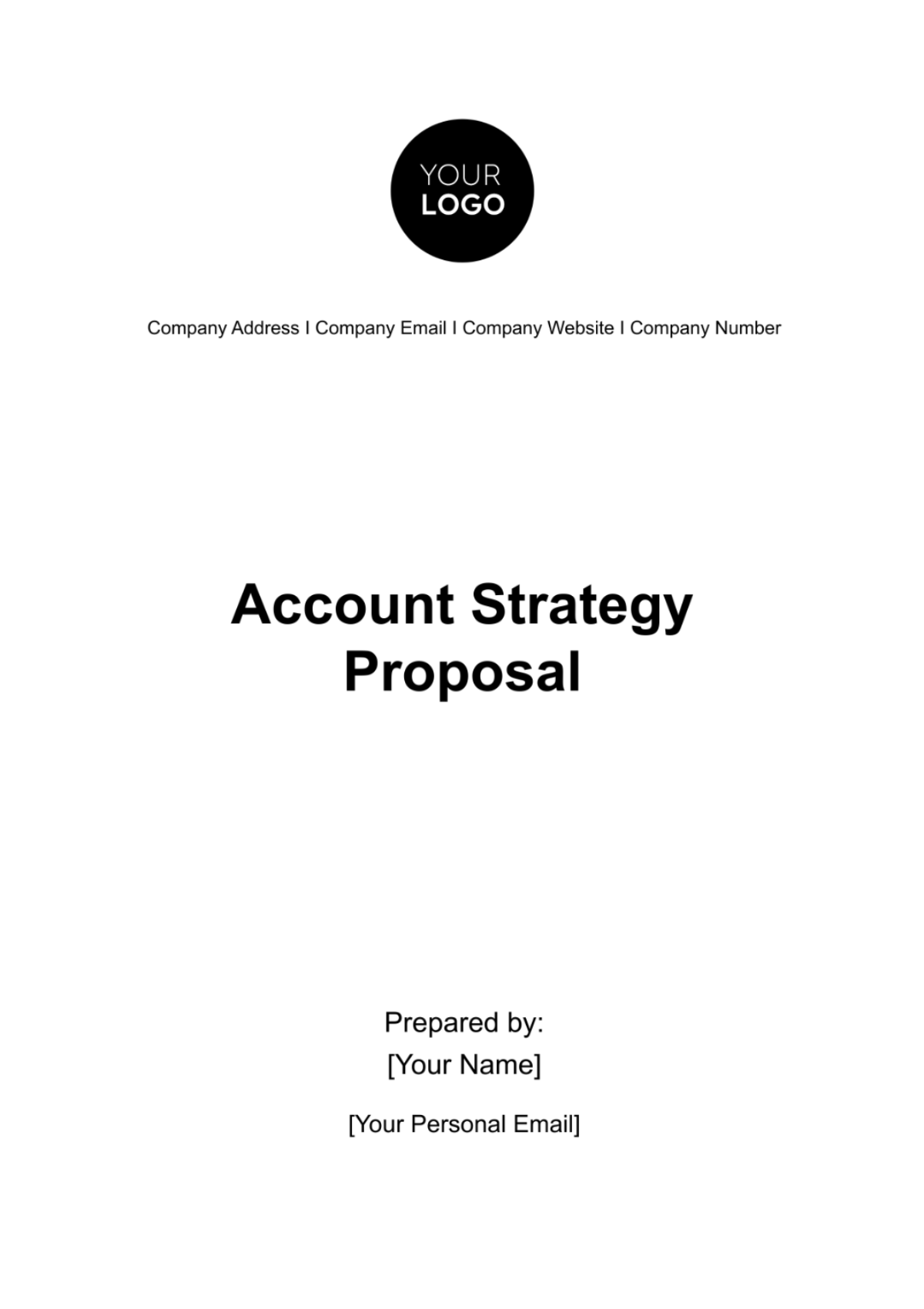Free Accounts Strategy Proposal Template
Executive Summary
This Accounts Strategy Proposal presents a comprehensive plan designed to revolutionize our approach to managing financial accounts. It is a strategic initiative aimed at enhancing the efficiency, accuracy, and compliance of our financial operations. This proposal outlines a series of strategic objectives, supported by a robust implementation plan, which are expected to significantly improve our financial management practices.
Key Objectives
Optimization of Financial Processes: Streamlining our accounting operations to improve efficiency and reduce errors.
Technology Integration: Implementing cutting-edge accounting software and tools to automate and enhance our financial processes.
Compliance and Risk Management: Ensuring strict adherence to financial regulations and implementing proactive risk management strategies.
Cost Reduction and Revenue Maximization: Identifying and implementing strategies to reduce operational costs and maximize revenue opportunities.
Anticipated Outcomes
A 20% reduction in operational costs related to financial processes within the first year.
Improved financial reporting accuracy, with a target of reducing reporting errors by 30%.
Enhanced compliance posture, reducing regulatory risks and penalties.
Strengthened financial health through better cash flow management and revenue recognition practices.
Introduction
The purpose of this proposal is to outline a strategic vision for transforming the way we manage our financial accounts. In the face of rapidly evolving financial landscapes and increasing regulatory demands, it is imperative that we adopt a more streamlined, efficient, and compliant approach to accounts management.
Current State of Accounts Management
Currently, our accounts management processes are characterized by a mix of manual and semi-automated systems. While functional, these processes are often time-consuming, prone to errors, and increasingly inadequate in terms of meeting the complex demands of modern financial reporting and compliance standards.
We face challenges such as delayed financial reporting, underutilization of financial data for strategic decision-making, and a higher-than-ideal rate of accounting discrepancies. Our current software and tools are outdated, leading to inefficiencies and a lack of integration with other business systems. Compliance with emerging financial regulations has become more challenging, exposing us to potential risks and penalties.
This proposal aims to address these challenges and set a new course for our financial management, aligning it with best practices and the overall strategic objectives of our organization.
Strategic Objectives
Our strategic objectives for accounts management are crafted to address current challenges and leverage emerging opportunities in financial management. These objectives are designed to transform our approach, aligning it with industry best practices and our overarching business strategy.
Enhance Efficiency through Automation: Implementing advanced software solutions to automate key financial processes, reducing manual labor and error rates.
Strengthen Compliance and Risk Management: Adapting to evolving regulatory requirements, minimizing the risk of non-compliance and financial penalties.
Optimize Cost Management: Streamlining operations to reduce costs associated with financial processes and transactions.
Data-Driven Decision Making: Leveraging financial data analytics for strategic decision-making, enhancing overall business performance.
Revenue Maximization: Identifying and implementing strategies to improve revenue collection and recognition.
Foster Sustainable Growth: Building a financial management framework that supports and sustains long-term organizational growth.
Market and Industry Analysis
The landscape of financial management is rapidly evolving, driven by technological innovation and regulatory changes. There's a notable shift towards digitalization and automation in financial processes, with more organizations adopting cloud-based accounting solutions. This transition not only enhances efficiency but also provides better scalability and flexibility in financial operations. Additionally, the integration of artificial intelligence and machine learning is revolutionizing data analysis, offering deeper insights and aiding in more informed decision-making.
Industry Best Practices
In the realm of accounts management, best practices revolve around three key areas: automation, compliance, and strategic financial planning. Automation in accounting processes is no longer a luxury but a necessity for operational efficiency and accuracy. Compliance with financial regulations has become more complex, necessitating robust systems to ensure adherence to these ever-changing standards. Furthermore, strategic financial planning, underpinned by accurate and timely financial data, is crucial for long-term sustainability and growth. Organizations excelling in these areas are often more competitive, adaptable, and financially sound.
Competitive Landscape
Our competitors are increasingly investing in advanced financial management systems, focusing on agility, compliance, and data-driven strategies. Many have already moved towards fully integrated financial systems that offer real-time data processing and analytics capabilities. This shift not only improves their operational efficiency but also enhances their ability to respond swiftly to market changes. To remain competitive, it is imperative for us to adopt similar advanced systems and practices, aligning our financial operations with these emerging industry standards.
Assessment of Current Accounts Management
An in-depth assessment of our existing accounts management system reveals critical insights into its operational effectiveness, compliance level, and strategic alignment. Understanding these aspects helps us identify areas for improvement and opportunities for growth. This assessment is crucial in informing the strategic direction of our proposed accounts management overhaul.
Strengths | Weaknesses | Opportunities | Threats |
Experienced Finance Team | Outdated Software Systems | Adoption of Advanced Technology | Emerging Financial Regulations |
Established Financial Processes | Manual Data Entry Processes | Integration with Business Intelligence Tools | Increasing Market Competition |
Strong Supplier Relationships | Inefficient Process Flow | Leveraging Data for Strategic Decisions | Technological Disruptions |
Compliance with Current Standards | Limited Analytical Capabilities | Cost-Savings through Process Optimization | Cybersecurity Risks |
Good Track Record of Meeting Deadlines | High Operational Costs | Expanding into New Markets | Economic Fluctuations |
The SWOT analysis highlights our competent team and established processes as key strengths, while pointing out the inefficiencies and technological inadequacies as major weaknesses. There are significant opportunities to improve through technology adoption and process optimization. However, threats such as rapidly changing regulations and market competition necessitate a proactive and strategic approach to our accounts management.
Proposed Accounts Management Strategy
In response to the insights gained from our market analysis and internal assessment, we propose a comprehensive strategy for modernizing our accounts management. This strategy is designed to address the current weaknesses, capitalize on opportunities, and mitigate threats, thereby aligning our financial operations with industry best practices and our organizational goals.
Key Components of the Proposed Strategy
Technology Integration: Implement state-of-the-art accounting software to automate and streamline financial processes.
Compliance Framework Enhancement: Develop a more robust compliance framework to adapt to evolving financial regulations.
Data Analytics and Reporting: Integrate advanced data analytics tools for real-time financial reporting and decision-making support.
Cost Management and Efficiency: Identify and implement measures to reduce operational costs associated with accounts management.
Risk Management: Strengthen risk management practices to safeguard against financial discrepancies and cybersecurity threats.
Continuous Training and Development: Regular training programs for staff to keep them updated with the latest accounting practices and technologies.
Strategic Financial Planning: Utilize enhanced financial data and analytics for long-term strategic planning and growth.
How the Proposed Strategy Differs from the Current Approach
The proposed strategy marks a significant shift from our current approach, primarily in its embrace of technological advancements and data-driven decision-making. Unlike the existing system, which relies heavily on manual processes and outdated software, the new strategy emphasizes automation and efficiency. This shift will not only reduce the time and resources spent on routine financial tasks but also enhance the accuracy and reliability of our financial data.
Furthermore, the current approach focuses on compliance with existing standards, whereas the new strategy proactively anticipates and adapts to future regulatory changes. By incorporating advanced risk management and compliance frameworks, we aim to stay ahead of potential financial risks and regulatory challenges.
The integration of data analytics represents a move towards a more strategic role for our accounts management, enabling us to derive actionable insights from financial data. This transition from a reactive, transactional focus to a proactive, strategic orientation is a cornerstone of the proposed strategy, positioning us for sustainable growth and competitive advantage.
Technology and Systems
The successful execution of our proposed accounts management strategy hinges on the adoption of advanced technology and systems. These technological solutions are selected to address the specific needs identified in our strategy, ensuring efficiency, compliance, and strategic financial management.
Technologies to Support the Strategy
Advanced Accounting Software: A comprehensive software suite capable of automating various accounting tasks, including invoicing, payroll, and financial reporting.
Data Analytics Tools: Tools that provide real-time analytics and insights into financial data, supporting strategic decision-making.
Cloud-Based Financial Management System: A cloud solution for enhanced accessibility, scalability, and data security.
Integrated Compliance Management Software: Software to monitor and ensure ongoing compliance with changing financial regulations and standards.
Cybersecurity Enhancements: Advanced security protocols and systems to protect sensitive financial data.
Automated Risk Management Solutions: Tools to identify and mitigate financial risks proactively.
Financial Analysis and Budgeting
A crucial aspect of implementing the new accounts management strategy is the financial analysis and budgeting, ensuring that the investment aligns with our financial objectives and offers a favorable return.
Proposed Budget for Strategy Implementation
Item | Estimated Cost |
Advanced Accounting Software | $200,000 |
Data Analytics Tools | $150,000 |
Cloud-Based System Implementation | $100,000 |
Compliance Management Software | $75,000 |
Cybersecurity Upgrades | $50,000 |
Risk Management Solutions | $50,000 |
Total | $625,000 |
Cost-Benefit Analysis
The total estimated investment for the strategy implementation is $625,000. This investment is anticipated to yield substantial benefits:
Operational Efficiency: Streamlined processes are expected to reduce manual labor costs by 25%, resulting in annual savings of approximately $80,000.
Error Reduction: Enhanced accuracy in financial reporting and compliance is projected to reduce financial discrepancies and associated costs by 30%, saving around $50,000 annually.
Strategic Decision-Making: Improved financial insights are expected to contribute to more effective strategic decisions, potentially increasing annual revenue by up to 10%.
Risk Mitigation: Proactive risk management is likely to decrease financial risks and compliance penalties, contributing to long-term financial stability.
Thus, the return on investment is projected to be significant, both in terms of direct financial returns and strategic benefits to the organization. The proposed budget aligns with our long-term financial objectives and is justified by the anticipated improvements in efficiency, compliance, and overall financial management.
Risk Management and Compliance
Implementing a new accounts management strategy entails various risks and compliance challenges. Identifying, assessing, and mitigating these risks is crucial to the success of the strategy. Simultaneously, ensuring compliance with relevant financial regulations is non-negotiable for our organization’s integrity and legal standing.
Risk | Likelihood | Impact | Mitigation Strategy |
System Implementation Failure | Moderate | High | Thorough planning, phased implementation, and regular progress reviews. |
Non-Compliance with Regulations | Low | Very High | Regular updates and audits of compliance systems, and staff training on regulatory changes. |
Data Security Breaches | Moderate | Very High | Implementing robust cybersecurity measures and continuous monitoring. |
Resistance to Change among Staff | High | Moderate | Comprehensive training programs and effective change management communication. |
Budget Overrun | Moderate | High | Strict budget monitoring and contingency planning. |
Technological Incompatibility | Low | High | Detailed technical assessment before implementation and consultation with IT experts. |
Implementation Plan
A well-structured implementation plan is critical for the seamless integration of the new accounts management strategy. The plan outlines the key tasks, timelines, and responsibilities, ensuring a coordinated and effective implementation.
Task | Month | Responsibility |
Strategy Approval and Budget Allocation | Month 1 | Senior Management |
Selection and Purchase of Software | Months 2-3 | IT Department |
System Installation and Setup | Months 4-5 | IT Department |
Staff Training on New Systems | Months 6-7 | Human Resources and IT Departments |
Phased Implementation of Systems | Months 8-10 | Accounts Department with IT Support |
Compliance Systems Upgrade | Months 11-12 | Compliance Officer and IT Department |
Monitoring and Review | Ongoing from Month 13 | Accounts and IT Departments |
Performance Metrics and Evaluation
To effectively measure the success and impact of the newly implemented accounts management strategy, it is crucial to establish clear performance metrics. These metrics will provide quantifiable targets that reflect the strategy's objectives, enabling us to evaluate its effectiveness and make data-driven adjustments.
Metric | Target |
Reduction in Process Time | Decrease processing time by 30% within one year |
Accuracy in Financial Reporting | Achieve a 95% accuracy rate in financial reports |
Compliance Adherence | 100% adherence to all regulatory changes within 3 months of enactment |
Cost Reduction in Financial Operations | Reduce operational costs by 20% within two years |
Employee Proficiency with New Systems | 90% staff proficiency within 6 months of implementation |
Cybersecurity Incidents | Zero cybersecurity incidents related to financial data in the first year |
Training and Development Needs
To support the successful implementation of our accounts management strategy, a comprehensive training and development program is necessary. This program will ensure that our staff is fully equipped to utilize the new systems and processes effectively.
Program | Duration | Audience |
Advanced Accounting Software Training | 2 Weeks | Accounts Department |
Data Analytics and Reporting | 1 Week | Accounts and Management Teams |
Compliance and Regulatory Training | 3 Days | Accounts, Compliance, and Legal Teams |
Cybersecurity Awareness | 2 Days | All Staff |
Change Management Workshop | 1 Day | All Staff involved in Implementation |
Conclusion
In conclusion, this Accounts Strategy Proposal lays out a comprehensive roadmap for transforming our approach to financial management. Through the adoption of advanced technology, enhancement of compliance frameworks, and emphasis on data-driven decision-making, we aim to significantly improve the efficiency, accuracy, and strategic impact of our accounts management. The investment in this strategy, though substantial, is justified by the expected improvements in operational efficiency, compliance adherence, and overall financial health. With a structured implementation plan, dedicated training, and clear performance metrics, we are confident in our ability to successfully navigate this transformation and achieve our strategic objectives.



